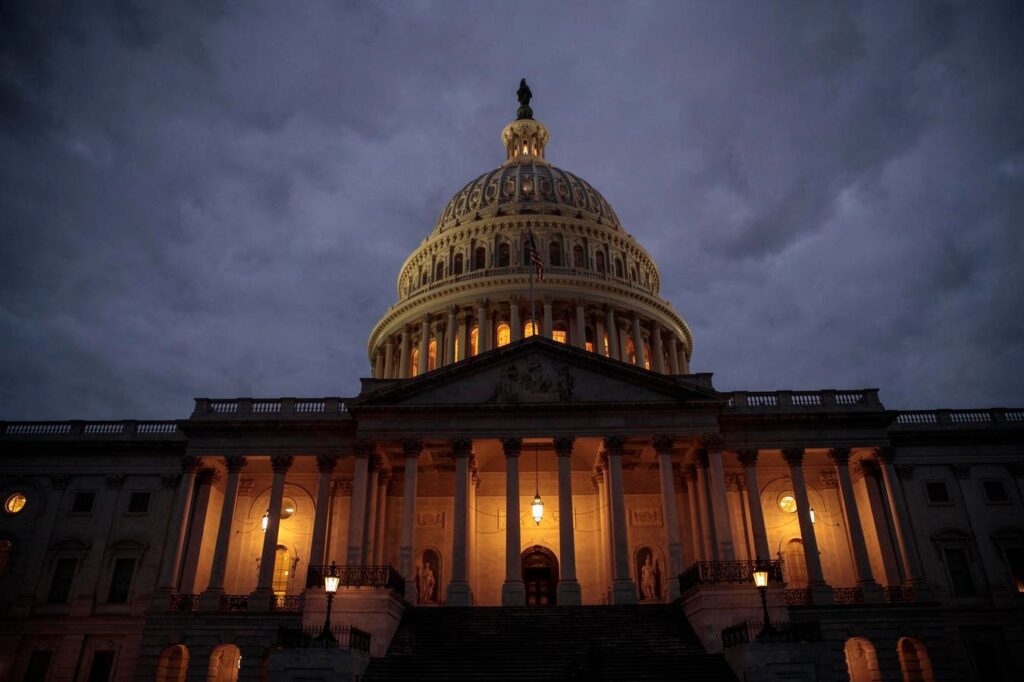WASHINGTON, DC – JANUARY 21: The U.S. Capitol is seen at dusk, January 21, 2018 in Washington, DC. Lawmakers are convening for a Sunday session to try to resolve the government shutdown. (Photo by Drew Angerer/Getty Images)
Getty Images
Last ditch talks between lawmakers might avoid a partial government shutdown, which could begin as soon as Wednesday morning. However, prediction markets currently view a partial shutdown as more likely than not. Should a shutdown occur, the main impact for financial markets will depend on how long it lasts.
Healthcare and Defense Sectors Likely To See Greater Impact
In the event of partial government shutdown, defense and healthcare companies could be disproportionately affected: Contracts with the government could be disrupted, causing further delays if the shutdown goes on for a while. And government approvals required of the healthcare sector could be delayed, potentially slowing new drug development, for example.
Historically most government shutdowns have lasted only a few days, so the impact of of delays has been relatively minimal. That said, the longest partial government shutdown, which lasted 35 days, beginning in December 2018, occurred during President Trump’s first term.
Possible Drag On Economic Growth
Beyond specific sector impacts, a partial government shutdown can have a dampening effect on economic growth. That’s because federal government workers are generally not paid during a shutdown. They are legally guaranteed backpay once the shutdown ends, but delayed paychecks can be a real economic blow for many households.
Federal government contractors are less secure; backpay is not guaranteed. The increased uncertainty and reduced spending from affected households have the potential to slow economic growth.
For now, estimates of economic growth are relatively robust. For example, the Atlanta Fed’s GDPNow model estimates third-quarter economic growth at an over 3% annualized rate, and the New York Fed’s Staff Nowcast estimates 2.5%.
Limited Impact on Essential Government Functions
It is also important to note that many essential functions of government are not impacted by a government shutdown. For example, Medicare and Social Security will continue to operate as will the U.S. Postal Service. Partial government shutdowns only impact those areas of government deemed non-essential. For example, this may include the national parks and the activities of NASA. What is deemed essential and non-essential for any shutdown is determined by the Office of Management and Budget.
Additional Government Layoffs Possible
Should a partial government shutdown occur, the Office of Management and Budget may look to implement additional layoffs. The OMB wrote in a memo regarding shutdown planning that, “Agencies are directed to use this opportunity to consider Reduction in Force (RIF) notices for all employees in programs, projects, or activities (PPAs) that satisfy all three of the following conditions: (1) discretionary funding lapses on October 1, 2025; (2) another source of funding, such as H.R. 1 (Public Law 119-21) is not currently available; and (3) the PPA is not consistent with the President’s priorities.”
What To Expect
Ultimately, the government may not shut down, depending on the outcome of final negotiations, thought prediction markets view a shutdown as likely.
If it’s resolved in hours, if not days, as has been the case historically, the economic impact of a brief shutdown can be relatively limited notwithstanding some heightened anxiety. However, a drawn out partial government shutdown has the potential for real economic harm, both for sectors of the economy with close government relationships and in potential reduction in economic growth due to the impact on federal workers.



